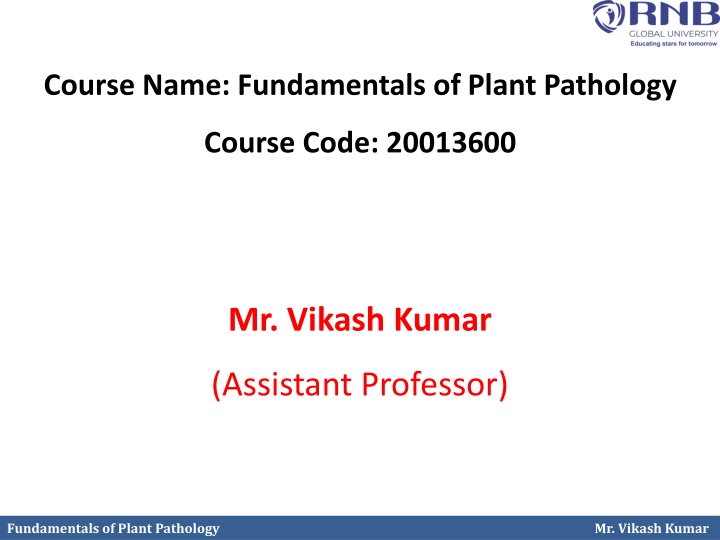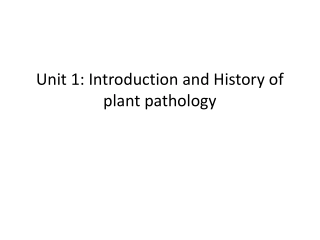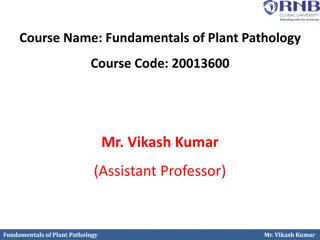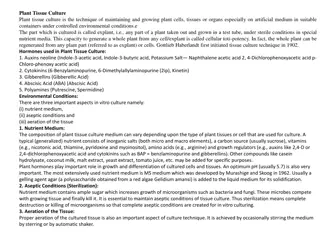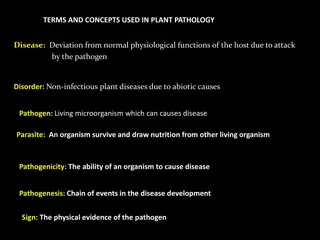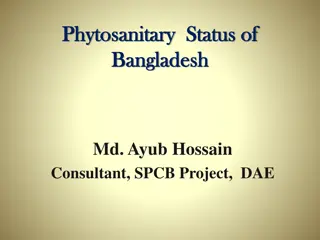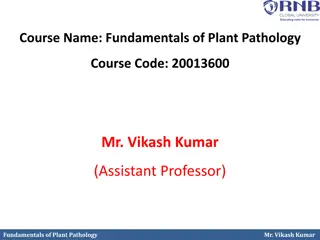Fundamentals of Plant Pathology with Mr. Vikash Kumar
This course covers topics such as diseases identification, pathogen nature, disease management strategies, nomenclature, classification of fungi, taxonomy, rules of nomenclature, and important nomenclature rules for organisms. Explore the binomial system of nomenclature, taxonomy, and classification of fungi with detailed explanations and examples. Learn about the significance of taxonomy and nomenclature in the study of fungi and scientific communication among mycologists and plant pathologists worldwide.
Download Presentation

Please find below an Image/Link to download the presentation.
The content on the website is provided AS IS for your information and personal use only. It may not be sold, licensed, or shared on other websites without obtaining consent from the author.If you encounter any issues during the download, it is possible that the publisher has removed the file from their server.
You are allowed to download the files provided on this website for personal or commercial use, subject to the condition that they are used lawfully. All files are the property of their respective owners.
The content on the website is provided AS IS for your information and personal use only. It may not be sold, licensed, or shared on other websites without obtaining consent from the author.
E N D
Presentation Transcript
Course Name: Fundamentals of Plant Pathology Course Code: 20013600 Mr. Vikash Kumar (Assistant Professor) Fundamentals of Plant Pathology Mr. Vikash Kumar
Course Objectives 1: Name and identify different Diseases, nature of pathogens and different strategies for management of plant diseases. 2: Outline concepts, nomenclature, classification and characters of pathogens 3: Apply different principles and methods for plant disease management. 4: Take a part in identification of diseases and marketing of relevant pesticides. 5: Conclude methods to diagnose and manage a wide range of plant diseases. Fundamentals of Plant Pathology Mr. Vikash Kumar
Nomenclature, Binomial system of nomenclature, rules of nomenclature, classification of fungi. Key to divisions, sub-divisions, orders and classes. Fundamentals of Plant Pathology Mr. Vikash Kumar
Taxonomy and nomenclature of fungi Taxonomy: The science of classification. Classification: Grouping of organisms into classes, orders, families, genera, species etc. Nomenclature: Art of naming of living organisms. Importance of taxonomy and nomenclature; 1. for study of fungi 2. for scientific communication between mycologists and plant pathologists throughout the world. Binomial system of nomenclature was originally introduced by Carl Linnaeus for higher plants. Later, this classification was adopted to fungi by his students C.H. Persoon and E.M. Fries (Linnaeus of mycology). Fundamentals of Plant Pathology Mr. Vikash Kumar
Some important rules of nomenclature : 1. According to International code of Botanical Nomenclature, the names of organisms should be binomial i.e., 2 parts. The first part is noun designating genus and the first letter of the genus name should be in capital. The second name is often an adjective, which denotes the species, and the first letter should be in small letter. Eg. Puccinia graminis. 2. Binomials are usually derived from Greek or Latin. 3. Binomials when hand written should be underlined and when printed italicised. Eg. Puccinia graminis (hand written) Puccinia graminis (printed) 4. Citation of name: The full name or abbreviation name of scientist who described fungus first, follows the species name. Eg. Puccinia graminis Persoon or Pers. Fundamentals of Plant Pathology Mr. Vikash Kumar
5. Citation of two authors names: If name of species is transferred to another genus from original (Botrytis infestans), the name of first author who first described species must be kept in parenthesis followed by name of second author who gave present status of species. Eg. Phytophthora infestans (Mont.) de Bary. 6. The taxa (groups) used in classification are Kingdom, Phylum, Class, Order, Family, Genus and Species. Each category may be sub divided into sub groups like Sub- Division, Sub- Class and Sub-Order. 7. Species is the unit of classification or basic taxonomic category (taxon). 8. Species sometimes broken into variety/formae speciales (f. sp.) and varieties into races and races into biotypes. Fundamentals of Plant Pathology Mr. Vikash Kumar
Standard endings of TAXA: Phylum ends with mycota Sub- Division ends with mycotina Class with mycetes Sub- class with mycetidae Order with ales Family with aceae No special ending for genus and species. Fundamentals of Plant Pathology Mr. Vikash Kumar
TAXA: Kingdom Phylum Sub-division Class Sub-class Order Sub-order Family Genera Species Fundamentals of Plant Pathology Mr. Vikash Kumar
Eg. Puccinia graminis tritici race 1 Kingdom: Fungi Phylum: Basidiomycota Sub-division: Basidiomycotina Class: Teliomycetes Order: Uredinales Family: Pucciniaceae Genus: Puccinia Species: graminis Variety: tritici Race: 1 Fundamentals of Plant Pathology Mr. Vikash Kumar
Classification of fungi According to Haksworth et.al. 1995 Fundamentals of Plant Pathology Mr. Vikash Kumar
1. Kingdom - Protists Phylum- Acrasiomycota Phylum- Dictyosteliomycota Phylum- Myxomycota Phylum- Plasmodiophoramycota 2. Kingdom - Stramenopila Phylum - Hyphochytriomycota Phylum - Labyrinthulomycota Phylum - Oomycota 3. Kingdom-Fungi Phylum - Ascomycota Phylum - Basidiomycota Phylum - Chytridiomycota Phylum - Zygomycota Fundamentals of Plant Pathology Mr. Vikash Kumar
1. Plasmodiophoromycota: These are obligate endoparasites. Commonly called as endoparasitic slime molds. Thallus is a plasmodium. Zoospores are anteriorly biflagellte, whiplash type. Members cause abnormal enlargement and multiplication of host cells i.e., hypertrophy and hyperplasia. Eg: Plasmodiophora causes club root of crucifers, Spongospora causes powdery scab of potato. 2. Oomycota: Thallus - mostly eucarpic, coenocytic. Also known as Water molds. Cell wall consists of cellulose. Chitin is absent. Asexual reproduction is by zoospores produced in zoosporangia. Zoospores are biflagelte (whiplash and tinsel) Sexual reproduction is by gametangial contact (- Oogonium and + anthreidium) produce oospore. Oospore is the sexual resting spore which is diploid. Example:- Pythium, Phytophthora, Albugo Downey mildew causing fungi (Perenospora, sclerospora etc.) Fundamentals of Plant Pathology Mr. Vikash Kumar
3. Ascomycota: Produce definite number (usually eight) of sexual spores (ascospores) in a sac like structure called ascus. Mycelium is septate, branched and organized into tissues known as plectenchyma. Absence of motile spores and presence of asexual spores called conidia. Cell wall containing chitin. Example:- Powdery mildew fungi (Penicillium, Venturia). Fundamentals of Plant Pathology Mr. Vikash Kumar
3. (1) Imperfect fungi/Deuteromycetes: Thallus: septate mycelium. Motile spores are absent. Sexual spores are absent. Only asexual spores called conidia are present. Imperfect stage or anamorphic stage is present. E.g. Fusarium, Alternaria 4. Basidiomycota: Thallus is septate mycelium. Motile spores are absent. Cell wall containing chitin Clamp connections and dolipore septum are present. Sexual spores are basidiospores produced specially 4 on club shaped basidium. Dikaryotic phase dominates the life cycle. E.g. mushrooms (Agaricus), rusts (Puccinia) and smuts (Ustilago). Fundamentals of Plant Pathology Mr. Vikash Kumar
5. Chytridiomycota: Thallus unicellular or coenocytic mycelium. Zoospores are posteriorly uniflagellate whiplash type. Asexual reproduction is by zoospores produced in zoosporangia. Zygote is converted into resting sporangium / resting spore. Eg. Synchytrium 6. Zygomycota: Absence of motile zoospores and production of non-motile sporangiospores (aplanospores). Well developed, coenocytic mycelium and cell wall with chitin. Asexual reproduction is by sporangiospores. Sexual reproduction produce of thick walled resting spore-zygospore. E.g. Rhizopus, Mucor Fundamentals of Plant Pathology Mr. Vikash Kumar
Thank You Fundamentals of Plant Pathology Mr. Vikash Kumar
